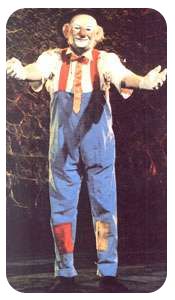|
In Shri 420, Raju, the quintessential Indian with the Japanese shoes, the English pantaloons and the made-in-India heart walks through the city squalor and comes up with a facile solution. In his progress-made-easy economics, income disparities can be eradicated through a mere catholicity of spirit, coupled with a bit of self-discipline, a little more labour on the part of the impoverished have-nots and some sharing and caring from the well-endowed ones is all that it takes to build Utopia. Now whoever talked of reconstruction and rebellion. Not the friendly neighbourhood tramp at least.
 It is the cause of the dispossessed again that is furthered in Ramesh Saigal's Phir Subah Hogi (1958). Ramu, the penniless law student, accidentally murders a man while trying to secure the money that would enable him to marry the woman of his dreams (Mala Sinha). Sohni, the daughter of an alcoholic traitor, can only be won when Ramu has paid off her father's debts. With no fair means permissible by the existing socio-economic set-up, Ramu must opt for the foul. He tries to rob the safe of the vicious moneylender and ends up killing him in self-defence. Later, in his confession, he launches a sentimental tirade against the rapacious rich who, in Kapoor's economics, were the prime beneficiaries of Nehruvian socialism and were impeding its smooth progress. Naturally, at the expense of the poor and the dispossessed who in the current set-up did not have even a roof over their heads. This despite the fact that the world was gradually coming to belong to the Indian nation. 'Chino-arab hamara, Hindustan hamara; rehne ko ghar nahin hai, sara jahan hamara' (China-Arabia may belong to us, Hindustan may belong to us, no home to live in, yet the whole world may belong to us) sings the disgruntled youth as he stumbles through an unfriendly clime, dreaming of a more equitable dawn. This new dawn would be one where everybody had a roof over his head, with adequate morsels of bread to feed himself and his family with spartan needs and simple demands. In such a set-up, the rich would remain rich, only the poor wouldn't be so poor. It is the cause of the dispossessed again that is furthered in Ramesh Saigal's Phir Subah Hogi (1958). Ramu, the penniless law student, accidentally murders a man while trying to secure the money that would enable him to marry the woman of his dreams (Mala Sinha). Sohni, the daughter of an alcoholic traitor, can only be won when Ramu has paid off her father's debts. With no fair means permissible by the existing socio-economic set-up, Ramu must opt for the foul. He tries to rob the safe of the vicious moneylender and ends up killing him in self-defence. Later, in his confession, he launches a sentimental tirade against the rapacious rich who, in Kapoor's economics, were the prime beneficiaries of Nehruvian socialism and were impeding its smooth progress. Naturally, at the expense of the poor and the dispossessed who in the current set-up did not have even a roof over their heads. This despite the fact that the world was gradually coming to belong to the Indian nation. 'Chino-arab hamara, Hindustan hamara; rehne ko ghar nahin hai, sara jahan hamara' (China-Arabia may belong to us, Hindustan may belong to us, no home to live in, yet the whole world may belong to us) sings the disgruntled youth as he stumbles through an unfriendly clime, dreaming of a more equitable dawn. This new dawn would be one where everybody had a roof over his head, with adequate morsels of bread to feed himself and his family with spartan needs and simple demands. In such a set-up, the rich would remain rich, only the poor wouldn't be so poor.
The conflict of Raj Kapoor's films always culminated in a scenario where, as he insists, all is well, everybody is happy and God is great. All within the existing social setup. For Kapoor's indictment was never against Nehruvian socialism. This was because the fifties, when Kapoor began his work, was still the age of idealism. Both as a film-maker and a hero, he retained a romantic optimism. Throwing light on his politics of cinema in Raj Kapoor, Ritu Nanda's biographical account of her father, he elucidates: "We began our work in an age of optimism. The republic was new, the rulers were new to leadership." This was an idealism which seemed to work despite the complexities and contradictions of the fifties. Small wonder then that Kapoor's call for reform, like his delineation of love, was intensely romantic too. The protagonists of the 1950s wanted a reformed social order, yes, but this could be achieved quite easily with a little bit of discipline, education and a lot of love.
Kapoor's ideology was basically a politics of love. "I saw the environment and the social effect it had on people and tried to weave the fabric of the script with the influences of that environment to present it with romanticism and a certain kind of sensitivity of belonging, of humanism and in totality, it worked as love."
|



